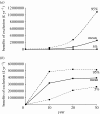Agricultural biosecurity
- PMID: 17761470
- PMCID: PMC2610114
- DOI: 10.1098/rstb.2007.2188
Agricultural biosecurity
Abstract
The prevention and control of new pest and disease introductions is an agricultural challenge which is attracting growing public interest. This interest is in part driven by an impression that the threat is increasing, but there has been little analysis of the changing rates of biosecurity threat, and existing evidence is equivocal. Traditional biosecurity systems for animals and plants differ substantially but are beginning to converge. Bio-economic modelling of risk will be a valuable tool in guiding the allocation of limited resources for biosecurity. The future of prevention and management systems will be strongly influenced by new technology and the growing role of the private sector. Overall, today's biosecurity systems are challenged by changing national priorities regarding trade, by new concerns about environmental effects of biological invasions and by the question 'who pays?'. Tomorrow's systems may need to be quite different to be effective. We suggest three changes: an integration of plant and animal biosecurity around a common, proactive, risk-based approach; a greater focus on international cooperation to deal with threats at source; and a commitment to refocus biosecurity on building resilience to invasion into agroecosystems rather than building walls around them.
Figures


Similar articles
-
A Systems Approach to Agricultural Biosecurity.Health Secur. 2018 Jan/Feb;16(1):58-68. doi: 10.1089/hs.2017.0035. Epub 2018 Feb 6. Health Secur. 2018. PMID: 29406805
-
Meeting the requirements of importing countries: practice and policy for on-farm approaches to food safety.Rev Sci Tech. 2006 Aug;25(2):685-700. Rev Sci Tech. 2006. PMID: 17094706 Review.
-
Breaking the mold: new strategies for fighting aflatoxins.Environ Health Perspect. 2013 Sep;121(9):A270-5. doi: 10.1289/ehp.121-a270. Environ Health Perspect. 2013. PMID: 24004721 Free PMC article. No abstract available.
-
Trade and commerce in improved crops and food: an essay on food security.N Biotechnol. 2010 Nov 30;27(5):623-7. doi: 10.1016/j.nbt.2010.06.009. Epub 2010 Jun 25. N Biotechnol. 2010. PMID: 20601266 Review.
-
Biosecurity: tools, behaviours and concepts.Emerg Top Life Sci. 2020 Dec 15;4(5):449-452. doi: 10.1042/ETLS20200343. Emerg Top Life Sci. 2020. PMID: 33313786
Cited by
-
Conciliation biology: the eco-evolutionary management of permanently invaded biotic systems.Evol Appl. 2011 Mar;4(2):184-99. doi: 10.1111/j.1752-4571.2010.00180.x. Evol Appl. 2011. PMID: 25567967 Free PMC article.
-
Modelling the impact and control of an infectious disease in a plant nursery with infected plant material inputs.Ecol Modell. 2016 Aug 24;334:27-43. doi: 10.1016/j.ecolmodel.2016.04.013. Ecol Modell. 2016. PMID: 27570364 Free PMC article.
-
Quantifying the hidden costs of imperfect detection for early detection surveillance.Philos Trans R Soc Lond B Biol Sci. 2019 Jul 8;374(1776):20180261. doi: 10.1098/rstb.2018.0261. Philos Trans R Soc Lond B Biol Sci. 2019. PMID: 31104597 Free PMC article.
-
Use of meteorological data in biosecurity.Emerg Top Life Sci. 2020 Dec 15;4(5):497-511. doi: 10.1042/ETLS20200078. Emerg Top Life Sci. 2020. PMID: 32935835 Free PMC article. Review.
-
Containment Studies of Transgenic Mosquitoes in Disease Endemic Countries: The Broad Concept of Facilities Readiness.Vector Borne Zoonotic Dis. 2018 Jan;18(1):14-20. doi: 10.1089/vbz.2017.2189. Vector Borne Zoonotic Dis. 2018. PMID: 29337664 Free PMC article.
References
-
- Anderson P.K, Cunningham A.A, Patel N.G, Morales F.J, Epstein P.R, Daszak P. Emerging infectious diseases of plants: pathogen pollution, climate change and agrotechnological drivers. Trends Ecol. Evol. 2004;19:535–544. doi:10.1016/j.tree.2004.07.021 - DOI - PubMed
-
- Anon. 2004 Cow with BSE likely to be one infected animal in the herd. J. Am. Vet. Med. Assoc., 15 February 2004. - PubMed
-
- Barker I, Brownlie J, Peckham C, Pickett J, Stewart W, Waage J, Wilson P, Woolhouse M. A vision of future detection, identification and monitoring systems. Office of Science and Technology; London, UK: 2006. Infectious diseases: preparing for the future.
-
- Baskin Y. Island Press; Washington, DC: 2002. A plague of rats and rubbervines: the growing threat of species invasions.
-
- Ben Jebara K. Surveillance, detection and response: managing emerging diseases at national and international levels. Revue Scientifique et Tecnique, Office International des Epizooties. 2004;23:709–715. - PubMed
Publication types
MeSH terms
LinkOut - more resources
Full Text Sources
Medical

